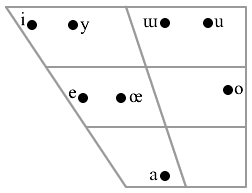Turkish phonology
The phonology of the Turkish language describes the set of sounds and their relationships with one another in spoken Turkish. One characteristic feature of Turkish is a system of vowel harmony that distinguishes between front and back vowels. The majority of words in Turkish adhere to a system of only having one of the two groups. Consonants are also affected, with palatal stops being present with front vowels and velar stops existing with back ones. Further details are given below.
Consonants
| Bilabial | Labio- dental |
Dental | Alveolar | Post- alveolar |
Palatal | Velar | Glottal | |||||||||
|---|---|---|---|---|---|---|---|---|---|---|---|---|---|---|---|---|
| Plosives | p | b | t | d | c | ɟ | k | ɡ | ||||||||
| Nasals | m | n | ||||||||||||||
| Fricatives | f | v | s | z | ʃ | ʒ | ɣ | h | ||||||||
| Affricates | tʃ | dʒ | ||||||||||||||
| Tap | ɾ | |||||||||||||||
| Approximant | j | |||||||||||||||
| Lateral approximants |
ɫ | l | ||||||||||||||
The phoneme /ɣ/ usually referred to as yumuşak g ("soft g"), ğ in Turkish orthography, actually represents a rather weak front-velar or palatal approximant between front vowels. It never occurs at the beginning of a word, but always follows a vowel. When word-final or preceding another consonant, it lengthens the preceding vowel.[1]
Vowels
| IPA chart for Turkish vowels |
|---|

|
The vowels of the Turkish language are, in their alphabetical order, a, e, ı, i, o, ö, u, ü. There are no diphthongs in Turkish and when two vowels come together, which occurs rarely and only with loanwords, each vowel retains its individual sound.
| Vowel sound | Example | |||
| IPA | Description | IPA | Orthography | English translation |
|---|---|---|---|---|
| vowel | ||||
| i | Close front unrounded vowel | dil | dil | 'tongue', 'language' |
| y | Close front rounded vowel | ɟy'neʃ | güneş | 'sun' |
| ɯ | Close back unrounded vowel | ɯˈɫɯk | ılık | 'mild, tepid' |
| e | Close-mid front unrounded vowel | jel | yel | 'wind' |
| œ | Open-mid front rounded vowel | ɟœɾ | gör- | 'to see' |
| a | Open front unrounded vowel | daɫ | dal | 'branch' |
| o | Close-mid back rounded vowel | joɫ | yol | 'way' |
| u | Close back rounded vowel | u'tʃak | uçak | 'airplane' |
Vowel harmony
The Turkish vowel system can be considered as being two-dimensional, where vowels are characterised by two features: front/back and rounded/unrounded. Vowel harmony is the principle by which a native Turkish word incorporates either exclusively back vowels (a, ı, o, u) or exclusively front vowels (e, i, ö, ü). The pattern of vowels is shown in the table below.
Grammatical affixes have "a chameleon-like quality"[2], and obey one of the following patterns of vowel harmony:
- twofold (-e/-a):[3] the locative suffix, for example, is -de after front vowels and -da after back vowels. The notation -de2 is a convenient shorthand for this pattern.
- fourfold (-i/-ı/-ü/-u): the genitive suffix, for example, is -in or -ın after unrounded vowels (front or back respectively); and -ün or -un after the corresponding rounded vowels. The notation -in4 is a convenient shorthand.
| Front | Back | |||
|---|---|---|---|---|
| Unrounded | Rounded | Unrounded | Rounded | |
| High | i | ü | ı | u |
| Low | e | ö | a | o |
The following examples, based on the copula -dir4 ("[it] is"), illustrate the principles of vowel harmony in practice: Türkiye'dir ("it is Turkey"), kapıdır ("it is the door"), but gündür ("it is the day"), paltodur ("it is the coat"). Compound words are considered separate words with regards to vowel harmony: vowels do not have to harmonize between the constituent words of the compound (thus forms like bu|gün ("today") or baş|kent ("capital") are permissible). In addition, vowel harmony does not apply for loanwords and some invariant suffixes, such as -iyor, the conjugation suffix for the present tense; there are also a few native Turkish words that do not follow the rule, such as anne ("mother"). In such words, suffixes harmonize with the final vowel: thus annedir ("she is a mother").
Stress
Stress is usually on the last syllable.[1] Exception include some suffix combinations, and loanwords (particularly from Italian and Greek) such as /ˈmasa/ (masa, "desk"), /ɫoˈkanta/ (lokanta, "restaurant"), or /isˈkele/ (iskele, "pier"). In many proper names the stress is transferred to the syllable before last (eg /isˈtambuɫ/, İstanbul), although there are exceptions to this (eg /ˈaŋkaɾa/, Ankara).
See also
References and notes
- ^ a b International Phonetic Association (1999). "Turkish". Handbook of the International Phonetic Association: A guide to the use of the International Phonetic Alphabet. Cambridge: Cambridge University Press. p. 155. ISBN 0-521-65236-7 (hb); ISBN 0-521-63751-1 (pb).
- ^ Lewis (1953):21
- ^ For the terms twofold and fourfold, as well as the superscript notation, see Lewis (1953):21-22. He later preferred to omit the superscripts, on the grounds that "there is no need for this once the principle has been grasped" (Lewis [2001]:18).
